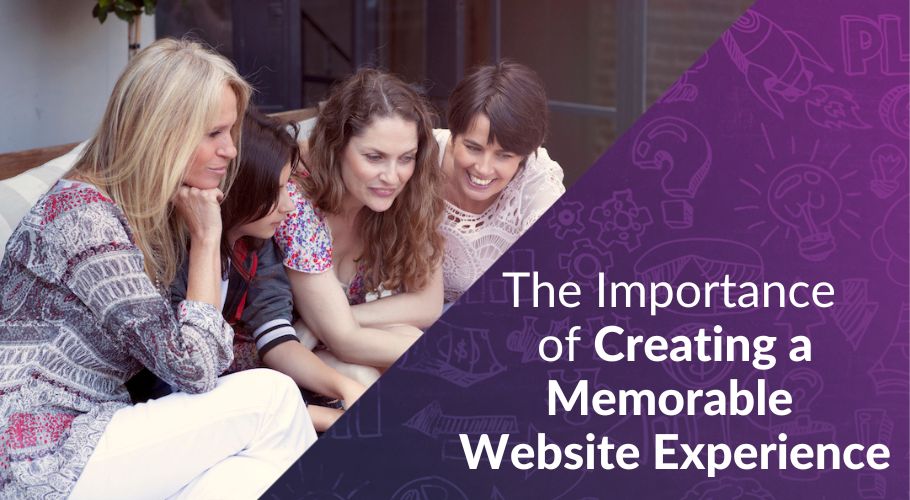Like it or not, creating a memorable website experience is integral to the success of your business.
Unfortunately, I’ve seen a lot of resistance to this concept, particularly from service-based business owners who work from a physical location, like a retail store or office.
In my experience, these kinds of people tend to focus more on their services and/or products, and the kind of impression they’re making with their physical location, while neglecting the quality of their website, or discounting its importance altogether.
But the fact is, your website is your virtual storefront.
So, even if you operate a brick-and-mortar store, do most of your business from the confines of an office, or have never made a single sale online, creating a lasting website impression is still incredibly important to the way that people perceive your brand.
Because let’s face it – regardless of what kind of business you own or how it operates, people are going to expect you to have a website. And if you don’t, it’s not going to look good from their perspective.
At the same time, having a website that’s outdated, hard to navigate, confusing, or otherwise offers a poor experience for users, is going to look just as bad, if not worse.
So, if you think your website needs some work, feel like it’s not performing the way it should, or just want to learn about first impressions in branding, as they pertain to websites, then you should definitely keep reading.
How to Create a Memorable Website Experience
Creating a memorable website experience requires you to have a deep understanding of the psychology of how people perceive websites, along with intimate knowledge of your target audience and the experience they’re expecting you to provide.
Let’s take a look at some research related to people’s perceptions of websites so you can have a better understanding of this concept.
A study from Google, which investigated how visual complexity and prototypicality (the degree to which something is typical or exemplary of the category to which it belongs) can affect website users’ first impressions, shows exactly what I’m talking about.
The study found that overall, websites with the lowest visual complexity and highest prototypicality are considered the most appealing.
In other words, if your website is visually appealing, easy to navigate, doesn’t confuse the user, and offers what they’re expecting, then more people are going to have a positive perception of it, and by extension, your brand.
The study concludes that “Designs that contradict what users typically expect of a website may trigger a suboptimal first impression and impair users’ expectations.”
Interestingly enough, the study also found that websites of low prototypicality are “judged as being unattractive” regardless of whether they contain high visual complexity or not.
So, if your website isn’t giving users what they want, they’re probably going to dislike it, no matter what it looks like.
What’s more, you’ve only got a matter of seconds to make a good impression on website users, so if you want to avoid the inevitable consequences of people’s negative perceptions, then this is something you’ve got to get right.
A Missouri University of Science and Technology study that used eye-tracking technology and an infrared camera to monitor students’ eye movements while they viewed websites provides more proof of this fact and also offers some insights into which website elements people tend to focus on the most.
The study found that it takes website users less than two-tenths of a second to form their first impression, and they tend to focus most of their attention on a website’s logo, navigation, search box, and social media links, along with its footer, main image, and written content.
Study participants also indicated that the use of colours influences their perceptions of websites and that the colours used should be “pleasant and attractive”.
Furthermore, they said that in order to get a favourable impression, the text on a website should be easy to read, and one of the study’s authors stressed the importance of using the right imagery, saying that “An inappropriate image can lead to an unfavorable response from viewers.”
I hope this helps you understand the psychology behind how people are viewing your website. If you want people to have a positive perception of your brand, it’s important to take psychology into consideration, not least in terms of website design and development.
But that’s not all… let’s go even further by exploring the role of senses in marketing.
Read: Crafting a Unique Selling Proposition: Unleashing the Power of Your Brand

If you want to create a memorable website experience, then you need to have a deep understanding of your brand.
But if you haven’t defined your unique selling proposition, then you’re not going to know what sets your brand apart from competitors, or how to position your brand in relation to your competition.
So, if you want to have a better grasp of your brand by learning about what a unique selling proposition is, and how to create one of your own, then this article is right up your alley.
The Role of Senses in Marketing
Stimulating the senses is crucial for creating a memorable website experience, and it can significantly improve the experience of users and the impression they have of your brand, making them more likely to want to do business with you.
So, whether we’re talking about a physical or digital storefront, the psychology behind creating a great first impression, and the role of senses in marketing, are pretty much the same.
For example, if you work in an office that hasn’t been cleaned in months, stinks to high heaven, and is furnished with old, stained, and damaged furniture, you’re probably not going to be closing many deals with clients.
If you’re someone who works in an office, I’m sure you’re well aware that if you want to be able to sell your services there, you’ve got to make sure it’s clean, visually appealing, comfortable, and doesn’t offend anyone’s senses.
The sensory aspects of this sort of environment are incredibly important, and this is true, regardless of whether we’re talking about your physical location or your website.
Let’s explore a few aspects of the senses, as they relate to your website, and look at how you can make sure you’re tapping into as many of them as possible.
Visual
Leveraging visual stimuli is crucial for enticing website users because it can significantly impact user engagement, keep them on your website for longer, and improve the user experience.
The first things users notice when they visit your website are the visuals, and a well-designed and visually appealing site immediately captures users’ attention, making a positive first impression.
Visual elements, such as images, videos, and graphics, can make the user experience more enjoyable and informative and can convey information more effectively than text alone.
Here are some tips for how you can ensure your website is stimulating users’ senses visually:
- High-Quality Imagery: Use high-resolution images and graphics that are relevant to your content or products. Ensure they are clear and visually appealing.
- Consistent Branding: Make sure to maintain a consistent visual style across your website to reinforce your brand identity. Use a cohesive colour palette, typography, and design elements.
- White Space: The effective use of white space can help create a clean and organized layout and ensure your website isn’t too visually complex. This helps to guide users’ attention to key visual elements and prevents clutter.
- Responsive Design: Make sure your website is responsive, meaning it adapts to different screen sizes and devices. This ensures that visual elements look good and function properly across all platforms.
- Video Content: If you can, you should incorporate video content wherever it’s appropriate. Videos can convey information more dynamically and effectively engage users.
Audible
Stimulating the senses audibly on a website can be a highly effective addition to the visual elements, especially when it comes to enticing and engaging users.
Audible stimuli, such as sound effects, music, or voiceovers, can captivate users and create a more immersive experience. What’s more, engaged users are more likely to spend time on your site, explore its content, and be interested in the services you’re offering.
At the same time, audio cues can help reinforce your brand identity, and sound can also be an effective way to convey information or guide users through specific actions on your site.
Here are some tips for how you can make sure your website is stimulating users’ senses audibly:
- Background Music: Consider adding background music that complements your website’s theme and content. But you’ve got to ensure that it’s not too distracting or loud, and that it can easily be turned off, as this can actually annoy people and detract from the user experience.
- Sound Effects: Sound effects can be used sparingly to enhance user interactions or highlight specific actions. For example, a subtle click sound when a button is pressed can provide feedback to users.
- Voiceovers: Using professional voiceovers to narrate important content, such as product descriptions, tutorials, or storytelling elements is another effective way to engage users, but make sure the voice is clear, pleasant, and in alignment with your brand’s voice.
- Audio Feedback: You can also provide audio feedback for user actions like form submissions or successful transactions, which helps users confirm that their actions have been completed successfully.
- User Controls: No matter what kind of audio you choose to use on your website, you should give users the option to control audio settings, such as volume and mute. Always respect users’ preferences and avoid auto-playing loud audio, as it can be disruptive. You might even want to keep everything muted by default to avoid annoying users.
Visceral
Making use of visceral stimuli on a website involves tapping into users’ emotional and instinctual responses to create a deep and memorable experience.
Visceral stimuli can evoke strong emotional responses in users, creating an emotional connection that can lead to increased user engagement, loyalty, and a higher likelihood that users will be interested in your services.
Ask yourself, how does your website make people feel?
When users have a visceral experience on your website, it’s more likely to stay in their memory, which can result in long-term brand recognition and a higher chance of them returning to your site.
Here are some tips for how you can ensure your website is stimulating users’ senses viscerally:
- Compelling Storytelling: Crafting compelling narratives can elicit highly emotional responses. You can do this by using storytelling techniques, visuals, and even audio to create a deep connection with your audience.
- Powerful Imagery: If you want to tap into the visceral aspect of users’ senses, you should choose images and visuals that evoke emotions relevant to your content or products. High-quality and emotionally resonant imagery can have a profound impact.
- Colour Psychology: You can also use colour psychology to your advantage. Different colours can evoke different emotions, so make sure to consider your brand colours and how they align with the emotional response you want to create.
- Typography and Font Choices: Typography and font choices can also influence the emotional tone of your website. So, make sure to select fonts that match your brand personality and messaging, and inspire the kinds of emotions you’re looking to invoke.
- Copywriting: The words you use on your website have the potential to elicit a visceral response from users. But whatever you choose to write, make sure that the text on your website is grammatically correct, consistently formatted, and is going to resonate with your audience and help to build trust with potential customers.
Do you need some help creating a memorable website experience? Let’s chat over a complimentary 30-minute discovery call or Contact us today to find out more about what we can do for you.
To your business success,
Susan Friesen
P.S. If you liked the article, you might want to subscribe to our newsletter. We publish tons of valuable content to help you learn more about marketing, and subscribing is the best way to ensure you don’t miss out. Additionally, if you’d like to learn more about building a search engine optimized website, click here for our free website guide.







